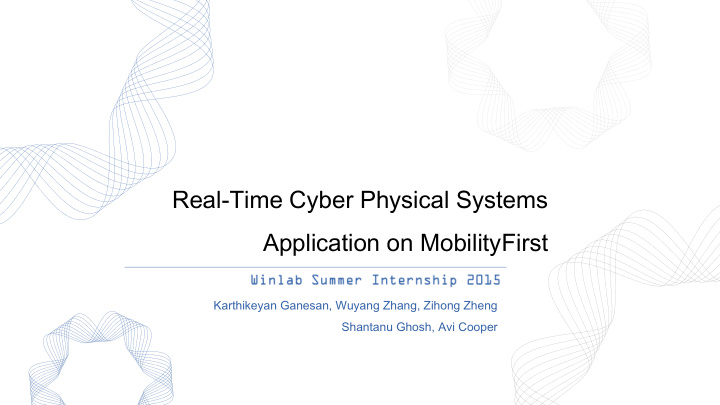



Real-Time Cyber Physical Systems Application on MobilityFirst Karthikeyan Ganesan, Wuyang Zhang, Zihong Zheng Shantanu Ghosh, Avi Cooper
WINLAB SUMMER 2015 TEAM M MEMBER BERS Karthi hikey eyan an Ganes esan an Wuyang ang Zhang ng Zihong ong Zheng ng Avi Cooper er Shant antanu anu Ghosh
WINLAB SUMMER 2015 PRE RELIM IMINARY INARY GOAL AL OF OUR UR PRO ROJECT ECT CPS Application based on MF Serv rver r side: e: Client ent side: de: Mobil ilityFi ityFirst rst Imple lement ment server ver Run an insta tance nce of Virtua tual Ne Networ work applicatio cation for object ct camera ra syste stem; m; recogn gniti ition on; Transmi nsmits ts video o in Return rn the result lt standard rd forma mat; t; Simple le graphical hical interf rface ce to display ay results lts
WINLAB SUMMER 2015 OUT UTLINE LINE OF THE HE PRO ROGR GRES ESS LOCAL SERVER CLIENT Image Database Camera Display Process COORD COORD Network Network MobilityFirst API
WINLAB SUMMER 2015 CU CURR RRENT NT FRA RAME Application: Linux APP: Achieved the Museum Scenario function. The Java version client is also built up. Google Glass: Got the Bluetooth transfer working. Doing combination now. Cloud Computing: Successfully set up the Hadoop Environment in ORBIT. Image Recognition: Reduced the processing time by removing the tree building phase. Trying to reach a solution using the ratio of matched descriptors to gain greater accuracy. Data Encryption: Working on OpenSSL stuffs.
WINLAB SUMMER 2015 Google Glass Why Google Glass? Glass provides us with access to both a camera that is recording exactly what the user is seeing, and a way to give information back to the user unobtrusively. What the user sees and how they sees it is very important. Outline of Glass captures video process : Results Camera Camera Bluetooth Why the phone as a go between? Glass is Data Data relatively low on battery and computing. Transferring networking to a phone will MF improve both battery life and networking Results speeds. Server runs image recognition software Android phone handles networking
WINLAB SUMMER 2015 Bluetooth transmission Bluetooth specs: Bluetooth can only send 20 byte packets at a time so my solution was to: 1. Split the byte array of the file (the image from the camera) into 17 byte packets 2. Give each packet a heading of its place among the other packets: 1. each byte has a range of 256. So with 3 counter- header bytes, times the 17 important bytes in the packet, there is a maximum transmission size of 285,212,672 bytes, or 272 MB. (With only 2 header- bytes, though there are 18 body- bytes, the maximum transmission size will only be 1.168 MB) 3. Receive each packet on the server side and place it into a 2D array, ordered by their headers. 4. Iterate though the array, pulling out only the body- bytes and place them into a single byte array. byte array layout: [counter, counter, counter, byte 1, byte 2, byte 3, byte 4, byte 5, byte 6, byte 7, byte 8, byte 9, byte 10, byte 11, byte 12, byte 13, byte 14, byte 15, byte 16, byte 17]
WINLAB SUMMER 2015 Google Glass- Progress Previous progress: The android Bluetooth APIs have been implemented on the Glass and the phone and the data transmission of very large files is about done. Separately, the MobilityFirst client code has been written for C++ and needs to be implemented in Java for android. Future Goals: The camera data collection needs to be implemented on the Glass and the MobilityFirst client code needs to be converted to be used for android. Also, a system to tell the user the results of the image recognition algorithm needs to be designed.
WINLAB SUMMER 2015 Hadoop Framework http://bradhedlund.com/2011/09/10/understanding-hadoop-clusters-and-the-network/#download
WINLAB SUMMER 2015 Hadoop Framework Background: present database size: 100 images vs practical requirements: over 5,000 images Current Progress: Configure Hadoop Environment on sb5 including two nodes, one for master, one for slave. Challenges: Incompatible coding language between Hadoop framework & CPS-project -> Implement Hadoop Streaming API
WINLAB SUMMER 2015 Da Data Encrypt yption Application ● Data at transport layer is split into blocks SocketManager ● GUID serves as public key ● Cipher used depends on Transport block size 10 10 10 11
WINLAB SUMMER 2015 OpenSSL SSL ● An open-source implementation of SSL/TLS ● Secure transmission of large amounts of data ● Libraries provide cryptographic/utility functions ● Capable of hosting multiple ciphers
WINLAB SUMMER 2015 DE DEMO O for Museum eum Scenari ario This is the TCP version. The client side is now displaying the result, including title, artist and date of the paintings.
WINLAB SUMMER 2015 Ne Next t Week k Plan Set et up the he conn nnection ection bet etwee een n mf ne networ ork k an and the he gen ener eral al compu mpute ter r through gh an access ss point. t. Develop op the client t progra gram based d on google gle glass s and Android oid phone. Improv rove the speed and accura uracy cy of the recogn gnition ition on Image ge processing cessing as aspect ect an and on n the he cloud d computing puting as aspect. ect. Try to impleme ment nt optima imal l dat ata en encrypti ption on using ng cryptogr ptographic/ut phic/utili ility ty function ions from om the OpenSSL SL core libra rary ry.
Question
Recommend
More recommend